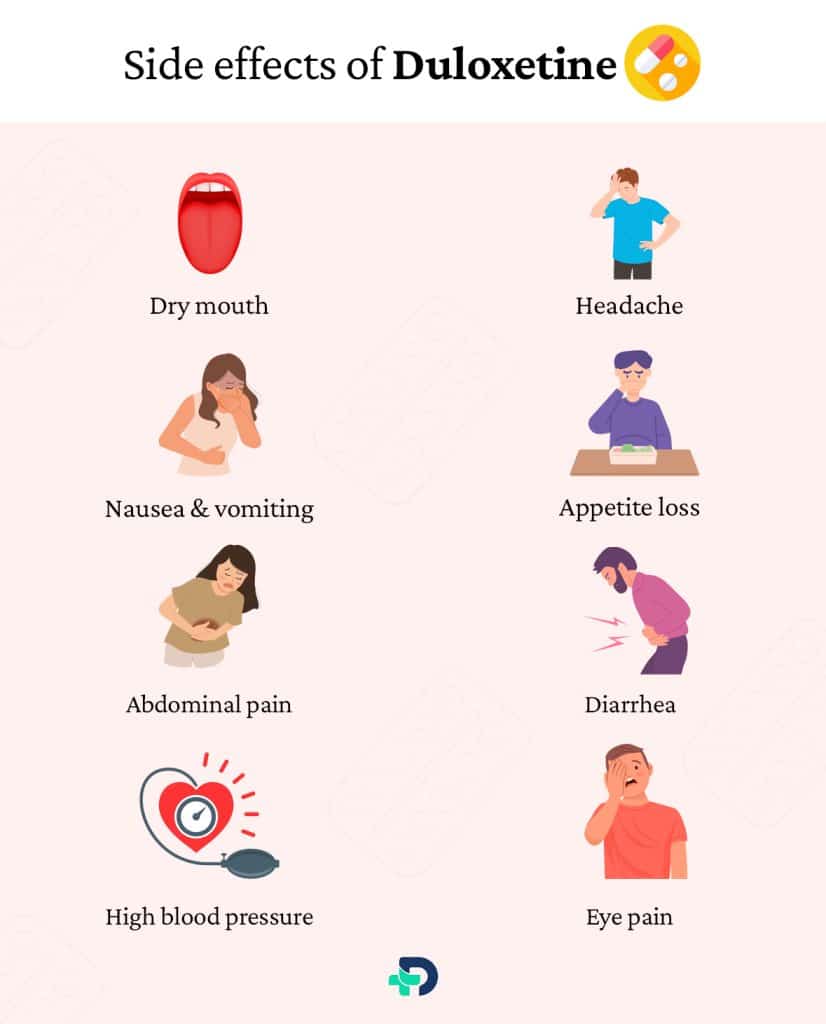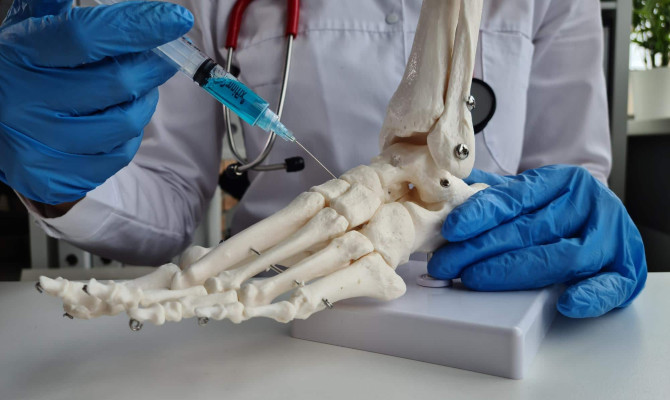Duloxetine: Uses, Side effects and Interactions

- Duloxetine
- 22 Aug 2023
Overview
What is Duloxetine?
Duloxetine is a prescription drug to treat depression, anxiety, and chronic pain in adults. It also helps treat generalized anxiety disorder in youngster.
The Duloxetine capsules are delayed release type, meaning the drug gets released and works after some time of consumption.

Facts of Duloxetine
- Duloxetine is a generic drug that is also available as trade name drug
- The other trade names of Duloxetin are Cymbalta, Irenka, and Drizalma Sprinkle.
- In 2004, the FDA (The Food and Drug Administration, United States) approved the Duloxetine drug.
- In 2008, the FDA approved the medication for fibromyalgia (musculoskeletal pain)
- In 2020, it was the most commonly prescribed drug in the United States, with over 22 million prescriptions 1Overview| Researched based study from Sciencedirect.com
Category of drug
- Duloxetine belongs to a class of medication known as serotonin-norepinephrine reuptake inhibitors (SNRIs)2Overview| Researched based study from Nlm.nih.gov
Mode of action of Duloxetine
- Duloxetine work by increasing the levels of brain chemicals viz; nor- epinephrine and serotonin. Decreased levels of serotonin and nor- epinephrine cause depression and anxiety.
- It prevents pain sensation transmission from nerves to the brain 3Overview| Researched based study from Nlm.nih.gov
Uses
Uses of Duloxetine
Duloxetine is used to treat the following conditions:
- Major depressive disorder
- Fibromyalgia
- Generalized anxiety disorder
- Diabetic neuropathy
- Chronic musculoskeletal pain
Major depressive disorder
It is a mood disorder that causes chronic sadness accompanied by symptoms such as:
- Appetite loss
- Interest loss in things
- Loss of concentration
- Irritability
- Difficult sleeping
- Weight changes (gain or loss)
Fibromyalgia
- Fibromyalgia is a persistent condition that causes body pain, tiredness, memory problem, and difficulty sleeping.
- Duloxetine is used to treat fibromyalgia in adults
Generalized anxiety disorder
Generalized anxiety disorder is the persistent worry about daily things along with other symptoms such as
- Anxiety
- Impatience
- Tiredness
- Difficult breathing
- Difficult sleeping
Duloxetine treats Generalized anxiety disorder in adults and youngsters seven years and older.
Diabetic neuropathy
- It is nerve destruction caused by diabetes (high sugar). It causes persistent nerve pain.
- Duloxetine is used to treat diabetic neuropathy in adults
Chronic musculoskeletal pain
- It is a painful condition that affects the muscles, bones, ligaments, and joints.
- Duloxetine is used to manage chronic musculoskeletal pain in adults 5Uses| Researched based study from Nlm.nih.gov
Dosage
Dosage of Duloxetine
The dose of Duloxetine will vary depending on the age, medical condition for which taken, and other health conditions.
Some of the commonly recommended doses of Duloxetine are as follows:
Major depressive disorder (Age-18 years and older)
- Initial dose-30 to 60mg (milligram) daily
- Maintenance dose-40mg daily in divided doses twice daily or 60 mg once daily or in divided doses twice daily
- Maximum dose-120 mg daily
Generalized anxiety disorder (Age- 18 to 64 years)
- Initial dose-30 to 60 mg daily
- Maintenance dose-60 mg daily
- Maximum dose-120 mg daily
Children (Age- 7 to 17 years)
- Initial dose-30 mg daily for two weeks
- Maintenance dose-30 -60 mg daily
- Maximum dose-120 mg daily
Older adults (65 years and older)
- Initial dose-30 mg daily for two weeks
- Maintenance dose-30 -60 mg daily
- Maximum dose-120 mg daily
Diabetes neuropathy nerve pain
Adult (Age-18 to 64 years)
- Initial dose-60 mg daily
- Maintenance dose-60 mg daily
Fibromyalgia (Age -18 years and older)
- Initial dose-30 mg daily for one week
- Maintenance dose-30 -60 mg daily
- Maximum dose- 60 mg daily
Adolescent (Age-13 to 17 years)
- Initial dose-30 mg daily for one week
- Maintenance dose-30 -60 mg daily
- Maximum dose- 60 mg daily
Chronic muscle and joint pain (18 years and older)
- Initial dose-30 mg daily for one week
- Maintenance dose-60 mg daily
- Maximum dose- 60 mg daily 4Dosage| Researched based study from Nlm.nih.gov
Side effects

Side effects of Duloxetine
Common side effects (adults)
- Dry mouth
- Headache
- Nausea and vomiting
- Extreme tiredness
- Drowsiness
- Appetite loss
- Excessive sweating
- Lightheadedness
- Difficulty clearing bowels
Common side effects (children)
- Nausea and vomiting
- Abdominal pain
- Diarrhea
- Decreased weight
- Lightheadedness
Serious side effects
- Extreme excitement
- High blood pressure
- Liver damage
- Bleeding more easily than usual
- Vision problem
- Eye pain
- Abrupt dip in blood pressure
- Fainting
- Low sodium level
- Uncontrolled muscle movement
- Confusion
- Memory problem
- Itching
- Hives
- Skin rash
- Swelling in the mouth, lips, tongue, and throat
- Difficult breathing
- Difficult urination
- Hallucination(false perception)
- Erectile dysfunction (sexual disorder in males) 6Side effects| Researched based study from Nlm.nih.gov
Formulation
Formulation of Duloxetine
Duloxetine comes in the following forms:
Delayed release Oral capsules
- One can swallow the capsule as a whole with water
- Power (Strength)-20 milligrams (mg), 30mg, 40mg, and 60mg
Sprinkle capsule form
- One can open the capsule and pour it into the food
Missed dose of Duloxetine
- In case of missed doses, take the dose immediately when you remember.
- However, if it is a few hours for the next dose, leave it and take the following amount on time.
- One unsure of taking the previous dose must be skipped, as a double dose at a time can bring about serious side effects.
Overdose
Overdose toxicity of Duloxetine
One must take Duloxetine as directed by the physician. However, accidental intake of a high dose of Duloxetine can have the following side effects:
- Extreme tiredness
- Nausea and vomiting
- Lightheadedness
- High blood pressure
- Abnormal heart rate
- Seizures (convulsions) 7Overdose| Researched based study from Nlm.nih.gov
One with excessive drug intake must dial the emergency medical number based on the geographical location or rush to the nearest emergency room.
Precautions
Before taking Duloxetine, one should exercise precautions
- Pregnant women should avoid using Duloxetine drug due to the lack of information on the safety and efficiency of these groups.
- Nursing mothers should avoid taking the drug as it might pass into the breast milk and might cause serious side effects in the child.
- Children younger than seven years should avoid taking the drug for generalized anxiety disorders due to inadequate information on the safety and effectiveness of the drug.
- People under 18 years must avoid taking the drug for other conditions due to a lack of information in these groups on the effectiveness of the drug 8Precautions| Researched based study from Nlm.nih.gov
Warnings of Duloxetine
Suicidal thoughts and behavior
- People under 24 years may experience suicidal thoughts on consuming Duloxetine.
Sleepiness
- Duloxetine may cause extreme tiredness and drowsiness associated with the inability of quick decision making and clear thinking.
Severe allergic reaction
Symptoms
- Swelling in mouth, lips, tongue
- Hives
- Difficult breathing
- Lightheadedness and fainting
Serotonin syndrome
Symptoms
- Coordination problem
- Confusion
- Agitation
- Increased heart rate 10Precautions| Researched based study from Nlm.nih.gov
Contraindications
Contraindications
Duloxetine may not be suitable for persons with the following health conditions:
- An allergic reaction to Duloxetine or any of the ingredients of the drug
- People with liver disease
- With kidney disease
- Having heart problems
- One with diabetes
- Having high blood pressure
- With bipolar disorder (mental condition)
- People with bleeding problems
- People with glaucoma (eye disease)
- Having seizure disorder
- People with low sodium in their blood
- With alcohol use disorder (addicted to alcohol) 9Contraindications| Researched based study from Nlm.nih.gov
Withdrawal symptoms
Withdrawal symptoms of Duloxetine
Sudden withdrawal of the drug can lead to severe withdrawal symptoms. Some of them are as follow:
- Anxiety
- Headache
- Sweating
- Nausea and vomiting
- Lightheadedness
- Difficult sleeping
- Diarrhea
- Tiredness
- Irritability
- Abnormal shock-like sensations in the body 12Withdrawal symptoms| Researched based study from Nlm.nih.gov
Interactions
Interactions of Duloxetine
Serotonergic drugs (Antidepressant drug)
- Taking Duloxetine and Serotonergic drugs viz; tryptophan together might increase the risk of serotonin syndrome, which could be fatal.
Non-steroidal anti-inflammatory drugs
- Non-steroidal anti-inflammatory drugs are drugs to reduce soreness and inflammation.
- Taking Duloxetine and Non-steroidal anti-inflammatory (NSAID) drugs viz; ibuprofen together might increase the risk of profuse bleeding.
Schizophrenia drugs (antipsychotic drugs)
- Taking Duloxetine and Schizophrenia drugs together viz; thioridazine might increase the blood levels of the drug in the body.
- It might increase the risk of irregular heartbeat
Anticoagulants (blood thinning medication)
- Taking Duloxetine, an anticoagulant such as warfarin, might enhance the risk of profuse bleeding.
Cancer medication
- Taking Duloxetine and cancer medication viz; doxorubicin might increase the blood levels of doxorubicin in the body.
- It might increase the side effect of the drug
Some other medications that might interact with Duloxetine are as follows:
- Sumatriptan (migraine drugs)
- Buspirone (Anxiety medication)
- Theophylline (Asthma drug)
- Tramadol (pain medication)
- Ciprofloxacin (antibiotic)
- Rasagiline (Parkinson’s disease medication)
- Linezolid(Antibiotic)
- Thioridazine(antipsychotic drug)
- Bupropion (antidepressant medication) 11Interactions| Researched based study from Nlm.nih.gov
Storage
Storage & disposal of Duloxetine
Storage conditions
- Store Duloxetine at room temperatures between 20 to 25 degrees centigrade
- Keep in a tightly closed container away from the direct sunlight
- Also, keep out of reach of children and young pets
Disposal
- Dispose of unused medicine in a sealed bag or thrash to prevent accidental overdose or death of animals or pets.
- Throw the medication whose expiry date has crossed
Cost
- The cost of Duloxetine might vary depending on several aspects, such as the geographical site, pharmacy in use, and insurance coverage.
- One can avail of financial assistance for Duloxetine tablets from two websites viz; Needy Meds and Medicine assistance tools. The websites also facilitate one in finding low-cost health stores and essential educational resources.
Takeaway
Key Takeaways
- Duloxetine is an FDA-approved prescription drug for managing depression, anxiety, and pain
- Duloxetine’s abrupt discontinuation can lead to withdrawal symptoms, so one must follow the discontinuation method as the physician advises
- Duloxetine has probable warnings and side effects. So, one must follow the accurate doses as approved by the physician.
Any feedback on this article?
 This Articles content was accurate
This Articles content was accurate Very Informative Article
Very Informative Article I have a question or a comment
I have a question or a comment
 This article contains inaccurate content
This article contains inaccurate content This article was not helpful
This article was not helpful I have a question or a comment
I have a question or a comment
We appreciate your helpful feedback!
Checkout our social pages
References
-
Science Direct
Duloxetine | Overview
-
National Library of Medicine
Duloxetine: A Review of Its Safety and Efficacy in the Management of Fibromyalgia Syndrome | Overview
-
National Library of Medicine
Duloxetine | Overview
-
National Library of Medicine
Duloxetine for the treatment of major depressive disorder: safety and tolerability associated with dose escalation | Dosage
-
National Library of Medicine
Duloxetine: a review of its use in the treatment of major depressive disorder | Uses
-
National Library of Medicine
Safety and adverse event profile of duloxetine'.| Side effects
-
National Library of Medicine
Duloxetine overdose causes sympathomimetic and serotonin toxicity without major complications | Overdose
-
National Library of Medicine
Exposure to duloxetine during pregnancy and risk of congenital malformations and stillbirth: A nationwide cohort study in Denmark and Sweden | Precautions
-
National Library of Medicine
Duloxetine-Induced Liver Injury in Patients with Major Depressive Disorder | Contraindications
-
National Library of Medicine
Duloxetine: meta-analyses of suicidal behaviors and ideation in clinical trials for major depressive disorder | Precautions
-
National Library of Medicine
Duloxetine: clinical pharmacokinetics and drug interactions | Interactions
-
National Library of Medicine
Symptoms following abrupt discontinuation of duloxetine treatment in patients with major depressive disorder | Withdrawal symptoms


































